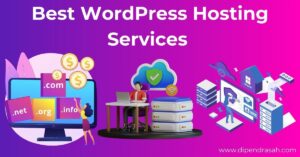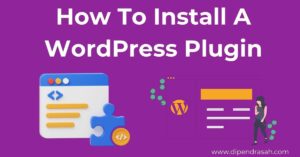Introduction to WordPress: The User-Friendly Website Builder
WordPress is an incredibly popular and versatile platform, powering over 40% of all websites on the internet. Its user-friendly interface, extensive customization options, and strong community support make it an ideal choice for both beginners and experienced developers. In this comprehensive guide, we will delve into what WordPress is, its benefits, and the steps involved in creating a WordPress website. From planning your site to optimizing it for search engines, we will cover everything you need to know to build a successful WordPress site.
Explanation of WordPress and Its Popularity Among Website Creators
WordPress is an open-source content management system (CMS) that allows users to create, manage, and publish content with ease. Its popularity stems from several factors:
- User-Friendly Interface: WordPress’s intuitive dashboard makes it easy for users of all skill levels to manage their websites.
- Flexibility: With thousands of themes and plugins available, WordPress can be customized to meet the needs of any website, from blogs to e-commerce stores.
- Community Support: A large, active community of developers and users contributes to regular updates, security improvements, and a wealth of tutorials and resources.
- SEO-Friendly: WordPress’s structure and numerous SEO plugins make it easy to optimize your site for search engines.
The Versatility of WordPress for Various Types of Websites
WordPress’s flexibility makes it suitable for a wide range of website types:
- Blogs: Originally designed as a blogging platform, WordPress excels at managing and presenting blog content.
- E-commerce Sites: With plugins like WooCommerce, WordPress can be transformed into a powerful e-commerce platform.
- Portfolios: Creative professionals can showcase their work using portfolio themes and plugins.
- Business Websites: Companies can create professional websites with contact forms, service pages, and more.
- Educational Sites: Learning management system (LMS) plugins enable the creation and management of online courses.
Ensuring a User-Focused Approach When Designing a WordPress Site
A user-focused approach is essential for a successful website. This involves:
- Intuitive Navigation: Ensure visitors can easily find the information they need.
- Responsive Design: Make sure your site looks good and functions well on all devices.
- Fast Loading Times: Optimize your site to load quickly to enhance user experience and reduce bounce rates.
- Accessibility: Ensure your site is accessible to all users, including those with disabilities.
Overview of the Steps to Create a WordPress Website
Creating a WordPress website involves several key steps:
- Planning Your Website: Define your website’s purpose, target audience, and goals.
- Choosing a Domain and Hosting: Select a domain name and a reliable hosting provider.
- Installing WordPress: Set up WordPress on your hosting server.
- Selecting and Installing a Theme: Choose a theme that aligns with your brand and customize it.
- Adding Content: Create and publish high-quality content that resonates with your audience.
- Optimizing for SEO: Implement SEO best practices to improve your site’s visibility.
- Maintaining Your Site: Regularly update your site, engage with your audience, and analyze metrics to refine your strategy.
Planning Your WordPress Website: Starting with the End in Mind
Identifying Your Website’s Purpose and Target Audience
Before you start building your WordPress site, it’s essential to identify its purpose and target audience. Ask yourself:
- What is the primary goal of my website? (e.g., selling products, sharing information, showcasing work)
- Who is my target audience? (e.g., demographics, interests, needs)
Understanding your website’s purpose and audience will guide your decisions regarding design, content, and functionality.
Setting SMART Goals for Your Website’s Functionality and Content
Setting SMART (Specific, Measurable, Achievable, Relevant, Time-bound) goals can help you stay focused and measure your website’s success. Examples of SMART goals include:
- Increase website traffic by 20% in the next six months
- Generate 50 new leads per month through contact forms
- Publish two blog posts per week
Choosing a Domain Name That Reflects Your Brand and Helps SEO
Your domain name is a crucial element of your online identity. It should be:
- Reflective of Your Brand: Choose a name that represents your brand and is easy to remember.
- SEO-Friendly: Include relevant keywords if possible, but avoid keyword stuffing.
- Short and Simple: Keep it concise and easy to spell.
Discussing Site Structure and Navigation for the Best User Experience
A well-organized site structure and intuitive navigation are critical for user experience. Consider the following:
- Clear Menu Structure: Organize your menu items logically and ensure they are easily accessible.
- Internal Linking: Use internal links to guide users to related content and keep them engaged.
- Breadcrumbs: Implement breadcrumbs to help users understand their location within your site.
Selecting the Right Hosting for Your WordPress Site
Understanding the Importance of Website Hosting and the Different Types Available
Website hosting is a service that stores your website’s files and makes them accessible on the internet. The right hosting is crucial for website performance, security, and reliability. There are several types of hosting:
- Shared Hosting: Multiple websites share the same server resources. It’s cost-effective but can lead to slower performance during peak times.
- VPS Hosting: Virtual Private Server hosting provides dedicated resources on a shared server. It offers better performance and scalability than shared hosting.
- Dedicated Hosting: Your website has an entire server to itself. It’s expensive but provides the best performance and security.
- Managed WordPress Hosting: A specialized hosting service optimized for WordPress sites, offering features like automatic updates, backups, and enhanced security.
How to Choose a Hosting Provider Based on Site Needs and Budget Constraints
When selecting a hosting provider, consider the following factors:
- Performance: Look for a provider with a reputation for fast load times and minimal downtime.
- Security: Ensure they offer robust security features such as SSL certificates, firewalls, and regular backups.
- Support: Choose a provider with 24/7 customer support to assist you with any issues.
- Scalability: Ensure the hosting plan can accommodate your website’s growth.
- Cost: Compare pricing and features to find a plan that fits your budget.
Discussing the Benefits of Managed WordPress Hosting for Non-Expert Users
Managed WordPress hosting is an excellent choice for non-expert users because it simplifies many technical aspects of running a website. Benefits include:
- Automatic Updates: The hosting provider takes care of WordPress core, theme, and plugin updates.
- Enhanced Security: Managed hosting providers offer advanced security features to protect your site.
- Performance Optimization: Managed hosting often includes caching, CDN integration, and other performance enhancements.
- Expert Support: Access to WordPress experts who can assist with troubleshooting and optimization.
Importance of Hosting for Website Performance and User Experience
The quality of your hosting directly impacts your website’s performance and user experience. Fast loading times, reliable uptime, and robust security are essential for keeping visitors engaged and protecting your site from threats.
Designing Your WordPress Website: Themes, Layouts, and Customizations
Navigating the World of WordPress Themes
WordPress themes are pre-designed templates that determine your site’s appearance and layout. There are thousands of themes available, ranging from free options to premium and custom designs. When choosing a theme, consider:
- Niche Relevance: Select a theme that suits your website’s purpose and industry.
- Customization Options: Look for themes that offer flexibility in design and functionality.
- User Reviews and Ratings: Check reviews and ratings to gauge the theme’s reliability and performance.
Customizing Your Theme to Reflect Your Brand Identity
Once you’ve selected a theme, customize it to match your brand identity. This includes:
- Colors and Fonts: Choose colors and fonts that align with your brand’s visual identity.
- Logo and Branding: Upload your logo and ensure consistent branding across your site.
- Layout Adjustments: Modify the layout to enhance user experience and highlight key content.
Best Practices for a Responsive Design
A responsive design ensures your website looks good and functions well on all devices, including desktops, tablets, and smartphones. Best practices include:
- Flexible Grid Layouts: Use grid layouts that adapt to different screen sizes.
- Media Queries: Implement CSS media queries to apply different styles based on device characteristics.
- Responsive Images: Use images that scale appropriately for different screen resolutions.
Using Page Builders and Plugins to Enhance Your Site’s Functionality
Page builders and plugins can significantly enhance your site’s functionality and design. Popular page builders include Elementor, Beaver Builder, and Divi. Key plugins to consider include:
- SEO Plugins: Yoast SEO, All in One SEO Pack
- Security Plugins: Wordfence, Sucuri Security
- Performance Plugins: WP Rocket, W3 Total Cache
- Contact Form Plugins: Contact Form 7, WPForms
Adding Content to Your WordPress Website: A Guide for Quality and Engagement
Creating and Publishing High-Quality, Original Content
High-quality, original content is the cornerstone of a successful website. Tips for creating engaging content include:
- Understand Your Audience: Create content that addresses the needs and interests of your target audience.
- Be Consistent: Publish content regularly to keep your audience engaged and improve SEO.
- Use Clear and Concise Language: Write in a way that is easy to understand and free of jargon.
Optimizing Content for Search Engines
Optimizing your content for search engines involves:
- Keyword Research: Identify relevant keywords and incorporate them naturally into your content.
- On-Page SEO: Optimize titles, meta descriptions, headers, and images for better search engine visibility.
- Readability: Ensure your content is easy to read and well-structured, using short paragraphs, headings, and bullet points.
Incorporating Multimedia Elements
Enhance user interaction and engagement by incorporating multimedia elements such as:
- Images: Use high-quality images to break up text and illustrate points.
- Videos: Embed videos to provide additional information and keep visitors on your site longer.
- Infographics: Create infographics to present complex information in an easy-to-understand format.
Ensuring Content Accessibility for All Users
Make sure your content is accessible to all users, including those with disabilities, by:
- Using Alt Text: Provide descriptive alt text for all images.
- Creating Accessible Forms: Ensure forms are navigable with a keyboard and screen reader-friendly.
- Readable Fonts and Colors: Use fonts and colors that are easy to read, with sufficient contrast between text and background.
Optimizing Your WordPress Site for Search Engines: An Introduction to SEO
Understanding the Fundamentals of SEO and Its Importance for Website Visibility
Search engine optimization (SEO) is the practice of improving your website to increase its visibility in search engine results. The higher your site ranks, the more likely you are to attract organic traffic. Key aspects of SEO include:
- Keyword Optimization: Using relevant keywords throughout your content to help search engines understand what your site is about.
- Quality Content: Providing valuable, engaging content that meets the needs of your audience.
- Technical SEO: Ensuring your site’s technical elements, such as speed and mobile-friendliness, are optimized for search engines.
Implementing WordPress SEO Plugins and Tools for Better Rankings
Several WordPress plugins can help you optimize your site for search engines:
- Yoast SEO: Offers on-page SEO analysis, XML sitemaps, and more.
- All in One SEO Pack: Provides similar features to Yoast, with some additional tools for advanced users.
- Rank Math: A newer plugin with a range of SEO features and user-friendly interface.
Researching and Using the Right Keywords Without Compromising User Experience
Keyword research involves finding relevant search terms that your target audience is using. Tools like Google Keyword Planner, SEMrush, and Ahrefs can help you identify these keywords. Incorporate keywords naturally into your content without compromising readability or user experience.
The Role of Backlinks, Social Sharing, and Other Off-Site Factors in SEO
Off-site SEO factors, such as backlinks and social sharing, also play a significant role in your site’s search engine rankings:
- Backlinks: Obtain high-quality backlinks from reputable sites to improve your site’s authority.
- Social Sharing: Encourage visitors to share your content on social media to increase visibility and drive traffic.
- Local SEO: Optimize for local search if your business serves a specific geographic area.
Maintaining and Growing Your WordPress Website: Tips for Long-Term Success
Keeping Your WordPress Site Updated and Secure
Regularly update your WordPress core, themes, and plugins to ensure your site remains secure and functions smoothly. Use security plugins like Wordfence or Sucuri to protect your site from threats.
Engaging with Your Audience Through Comments, Forums, and Social Media
Build a community around your site by engaging with your audience:
- Comments: Respond to comments on your blog to foster discussion and build relationships.
- Forums: Create forums for visitors to interact and share information.
- Social Media: Promote your content on social media platforms to reach a broader audience and drive traffic to your site.
Analyzing Website Metrics to Understand User Behavior and Refine Your Strategy
Use tools like Google Analytics to monitor your site’s performance and understand user behavior. Analyze metrics such as traffic sources, bounce rates, and conversion rates to refine your strategy and improve your site’s effectiveness.
Continuous Learning and Adapting to New Trends and Technologies in the WordPress Ecosystem
Stay up-to-date with the latest trends and technologies in the WordPress ecosystem by:
- Following Industry Blogs and News: Keep informed about updates, best practices, and new tools.
- Participating in WordPress Communities: Engage with other WordPress users and developers through forums and social media groups.
- Attending WordPress Events: Participate in WordPress events like WordCamps and meetups to learn from experts and network with peers.
By following these guidelines, you can create a successful WordPress website that meets your goals, engages your audience, and grows over time. Remember, building and maintaining a website is an ongoing process, so continually seek ways to improve and adapt to new challenges and opportunities.



